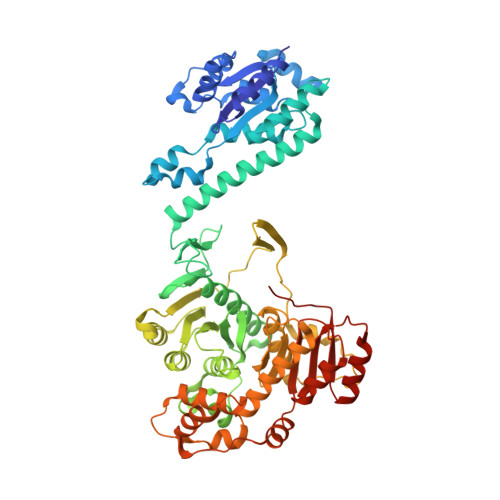Crystal structure of avian aminoimidazole-4-carboxamide ribonucleotide transformylase in complex with a novel non-folate inhibitor identified by virtual ligand screening.
Xu, L., Li, C., Olson, A.J., Wilson, I.A.(2004) J Biol Chem 279: 50555-50565
- PubMed: 15355974
- DOI: https://doi.org/10.1074/jbc.M406801200
- Primary Citation of Related Structures:
1THZ - PubMed Abstract:
Aminoimidazole-4-carboxamide ribonucleotide transformylase (AICAR Tfase), one of the two folate-dependent enzymes in the de novo purine biosynthesis pathway, is a promising target for anti-neoplastic chemotherapy. Although classic antifolates, such as methotrexate, have been developed as anticancer agents, their general toxicity and drug resistance are major issues associated with their clinical use and future development. Identification of inhibitors with novel scaffolds could be an attractive alternative. We present here the crystal structure of avian AICAR Tfase complexed with the first non-folate based inhibitor identified through virtual ligand screening of the National Cancer Institute Diversity Set. The inhibitor 326203-A (2-[5-hydroxy-3-methyl-1-(2-methyl-4-sulfophenyl)-1H-pyrazol-4-ylazo]-4-sulfo-benzoic acid) displayed competitive inhibition against the natural cofactor, 10-formyl-tetrahydrofolate, with a K(i) of 7.1 mum. The crystal structure of AICAR Tfase with 326203-A at 1.8 A resolution revealed a unique binding mode compared with antifolate inhibitors. The inhibitor also accessed an additional binding pocket that is not occupied by antifolates. The sulfonate group of 326203-A appears to form the dominant interaction of the inhibitor with the proposed oxyanion hole through interaction with a helix dipole and Lys(267). An aromatic interaction with Phe(316) also likely contributes to favorable binding. Based on these structural insights, several inhibitors with improved potency were subsequently identified in the National Cancer Institute Compound Library and the Available Chemical Directory by similarity search and molecular modeling methods. These results provide further support for our combined virtual ligand screening rational design approach for the discovery of novel, non-folate-based inhibitors of AICAR Tfase.
Organizational Affiliation:
Department of Molecular Biology, The Scripps Research Institute, La Jolla, CA 92037, USA.
















